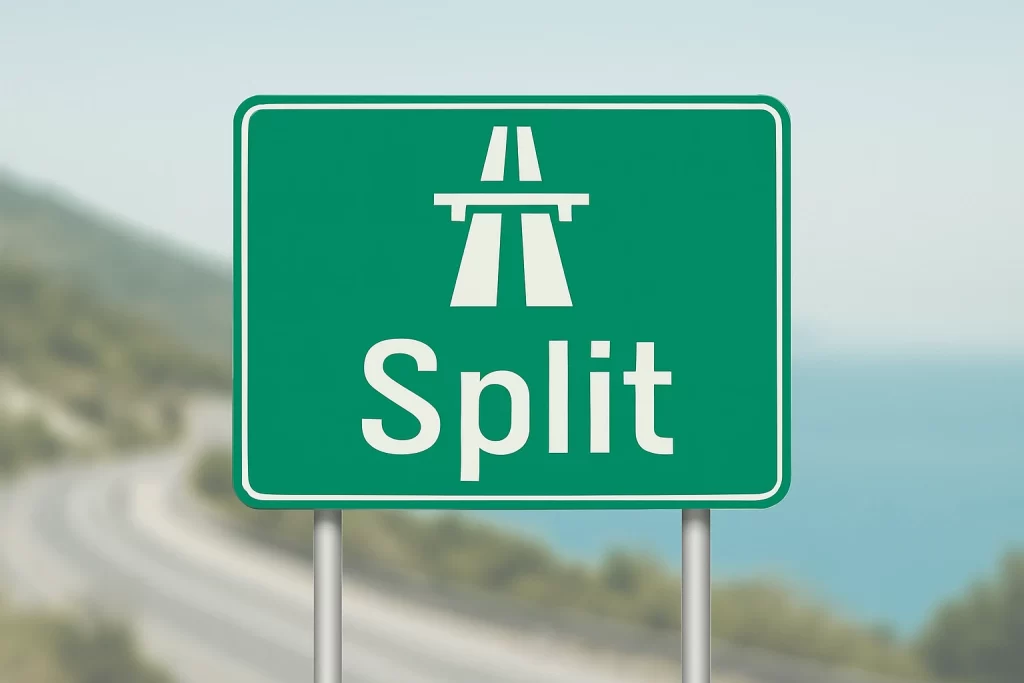Croatia has one of the most elaborate and high-quality highway networks in Croatia, and using it to its fullest can save quite a bit of time and money for any driver visiting Croatia during the summer. The most important thing to know is that Croatia uses a pay-per-distance (cestarina, toll) model instead of a vignette model. This means that the exact cost depends on the route, vehicle class, and distance travelled.
This guide aims to help you find out what A1 motorway prices look like in 2025, how much you’ll pay for a trip between Split and Zagreb, and what payment options are available. Planning ahead will help you budget, avoid long lines and avoid stress (that often happens on Croatian highways, sadly).
Before you start
Please download the HAK app before driving in Croatia, it’s free, very well-made, and one of the best helps you can possibly have during your stay.
Croatian motorway tolls
Croatia does not use a highway vignette system. Instead, drivers collect a ticket when entering a tolled motorway and pay when exiting. Toll fees are based on the distance travelled and vehicle category. Only motorways carry tolls; state and county roads are completely free (and often overlooked). While our roads are not as expensive as you’d expect, the sheer volume of tourists makes them a crowded place to be, so trying some other routes might actually be a better idea sometimes.
Speed limits in Croatia
| Road type | Speed limit |
| Highway (autocesta) | 130 km/h |
| Expressways (fast roads, brza cesta) | 110 km/h |
| Open roads | 90 km/h |
| Urban areas | 50 km/h |
Road traffic regulations
| Regulation | Details |
| Seat belts | Mandatory for all passengers |
| Alcohol limit | 0.0% BAC for drivers under 25; 0.5% for drivers 25+ |
| Phone use | Prohibited unless handsfree |
| Required items in car | Warning triangle, reflective vest, first aid kit |
Vehicle categories
Toll rates vary with vehicle class. According to Hrvatske autoceste (HAC), categories include motorcycles (IA), passenger cars up to 1.9 m high (I), high vehicles or cars with trailers (II), three‑axle vehicles (III) and heavy trucks/buses (IV). Most tourists will drive a category I car, so have that in mind when looking at the numerous pictograms on the highways.
Operators and roads
Three operators manage Croatia’s highway network:
- HAC (Croatian Highways) runs most motorways, including the A1 (Zagreb–Split–Ploče), A3 (Bregana–Zagreb–Lipovac), A5 (Beli Manastir–Osijek–Svilaj) and A6 (Zagreb–Rijeka). This is the national highway operator in Croatia.
- Bina‑Istra operates the Istrian Y (Istarski ipsilon) (A8/A9) network on the peninsula.
- AZM (Autocesta Zagreb-Macelj) manages the A2 motorway between Zagreb and the Slovenian border.
These roads combine to just over 1000 kilometers of fast and well-maintained roads. These highways link all of Croatia’s major cities and borders and are parts of other European routes and corridors. The most popular and important highway is the A1, which connects Zagreb to the coastal cities of Zadar and Split.
Can you get from Zagreb to Dubrovnik via highway?
Sadly, no, so have that in mind. The highway ends in Ploče, and from there you need to drive around an hour and a half to reach Dubrovnik.
Toll payment methods
Paying at booths
Croatia’s toll gates accept euro cash and most international credit/debit cards. When you enter the motorway, take a ticket from the machine; when exiting, hand the ticket to the operator. I’d suggest using the automated booths for ease of access and speed. These are often located on the popular routes and toll booth locations, such as entries and exits to Zagreb, and make the experience much faster.
If you do have to pay to a real-world person, its much easier to pay by card than by cash; you simply give both your card and the cash to the operator, and he or she will do the rest. There is no need for PINs on the highway system, and it’s perfectly safe.
Electronic toll collection (ENC)
Frequent drivers (most often locals) can save time by using an ENC (ETC) on‑board unit. The device allows you to use dedicated toll lanes and enjoy discounts up to 21 % on prepaid accounts or 33 % on off‑season accounts. You can purchase an ENC unit for about €15 from HAC points of sale or online. ENC accounts are not tied to a specific licence plate and can be used across multiple vehicles of the same class. A separate tariff is required for the Bina‑Istra network.
Payment tips
- Always carry some euro cash for smaller tolls or if card systems are down.
- Avoid peak times (weekend change‑overs in July/August); queues at toll plazas can be long.
If using ENC, top up your account before travelling and download the HAC ENC app to monitor balances. ENC is a good idea if you’re traveling often, but have in mind that it’s sometimes not working, and you’ll have to stop at the ramp until it detects the signal.
We’re working hard on an overhaul of the highway system, and it should be online in a few years.

Calculating toll costs
Example costs for 2025
The official HAC tariff table provides detailed prices for each exit. For category I cars (height ≤ 1.9 m), examples include:
| Route (Exit) | Distance & motorway | 2025 toll (€) | Notes |
| Zagreb – Karlovac | 48 km on A1 | 2.80 | Short hop to Plitvice Lakes |
| Zagreb – Zadar | 253 km on A1 | 17.60 | Coastal gateway |
| Zagreb – Split | ~410 km on A1 | 26.40 | Popular Split to Zagreb toll cost route |
| Zagreb – Ploče | 470 km on A1 | 33.80 | Includes Pelješac Bridge |
| Zagreb – Rijeka | 135 km on A1/A6 | 10.10 | Access to Istria via A7 |
| Zadar – Split | 150 km | 8.10 | Short coastal segment |
The A1 motorway prices 2025 table shows the full list from Zagreb to Čarapine (last toll station before Ploče), ranging from €1.00 at Jastrebarsko to €33.80 at Čarapine. Additional tunnels or bridges such as Krk Bridge or Učka Tunnel may have separate tolls not included in the motorway fee.
Price increases in 2025
Croatian highway tolls rose by 5–10 % in early 2025. Expect increase in ranges of €1–33.80 on the A1/A6/A10 corridor and €1.70–18.60 on the A3/A5 routes. This is good to know if you’re a regular visitor and expect a certain price.
Croatia toll calculator
Split to Zagreb toll prices
For many travellers the Split–Zagreb run is the core motorway trip. As of 2025, a passenger car (category I) will pay €26.40 from Zagreb (Lučko toll) to the Split exit. Motorcycles pay €15.80, while high vehicles pay €41.40. Additional fuel costs (~410 km) should also be factored; average petrol prices mid‑July 2025 are €1.51 per litre. Have in mind that the Croatian government regulated fuel prices in the last year, but that has changed so fuel stations on the highways often charge more for a liter than those located in cities.
Tolls vs vignettes – what’s the difference?
Some European countries require you to buy a vignette (time‑based permit) before accessing highways. In Croatia there is no vignette; you only pay for the kilometres driven. A vignette might cost a flat fee for a certain amount of days, whereas Croatian tolls vary per route. This pay‑per‑use system means shorter trips can be cheaper than in vignette countries like Slovenia or Austria, but long cross‑country journeys may end up costing more. Moves are being made to change this to a more high-tech system which will scan licence plates and automate most of highway tolls in Croatia.
Pelješac bridge toll fees
As with many other bridges in Croatia, the Pelješac bridge has no tolls – it’s open to everyone and is not a part of our highway system, which means that it’s just like any other bridge in Croatia.
Tips for a smooth toll‑road experience
Plan your route and budget: Check the toll calculator and know your costs in advance. Factor tolls into your road‑trip budget alongside fuel and accommodation.
Mind the vehicle category: High vehicles (e.g., campervans with roof boxes) may be classed as category II; tolls can be almost double those of category I. Remove roof racks if possible.
Avoid heavy traffic: HAC advises travelling early morning or late evening and avoiding peak weekends, especially in July and August.
Monitor road and weather conditions: Use the tools in our toolkit to find out traffic and weather info. Winter storms and high summer winds may temporarily close mountain sections of the A1.
Emergency numbers: Dial 112 in Croatia for police, ambulance or roadside assistance. The Croatian Auto Club (HAK) emergency number for breakdowns is 1987.
Consider ENC for longer trips: If you’re driving multiple motorways, invest in an ENC device for discounts and to skip queues.
Good luck and have a great time visiting my country!
Croatia does not use vignettes. Instead, we opt for a pay-as-you-go system, where tolls are paid at toll booths.
Yes. All toll stations accept Visa, Mastercard and Maestro. Many allow contactless payment.
No, driving on the Pelješac bridge is free of charge.
